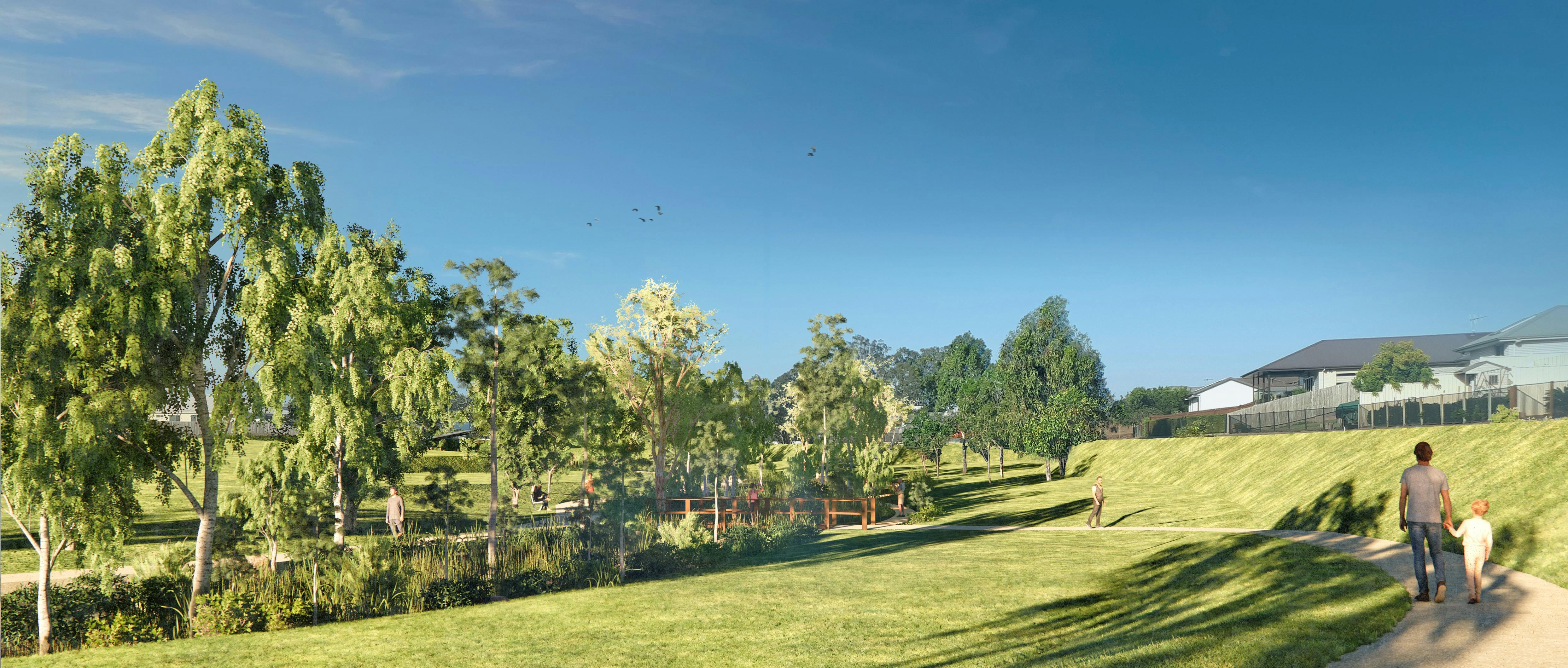FAQs
- To improve stormwater quality and treat polluted stormwater runoff which is harmful to sensitive downstream waterways and ecosystems (i.e. Baldwin Swamp);
- To improve fish habitat and connectivity;
- To improve the connectivity of Council’s active transport network (suitable for those who are mobility impaired) by providing a footpath link from Belle Eden Drive to Gum Nut Drive Park and from Longview Drive to Belle Eden Park (including an additional bridge crossing);
- To further activate the area and engage the community with Belle Eden Park by providing a picnic shelter, park benches, rock crossings, additional trees for shade and grassed open spaces for active play; and
- To improve the aesthetics of Belle Eden Park.
Why Belle Eden Park Waterway?
Belle Eden Park Waterway offers a unique opportunity to enhance the natural beauty of the area, improve waterway health and provide improved connection networks for the local community. Council has also received voluntary financial contributions from developers to improve stormwater quality.
Where will the new waterway be?
Belle Eden Park Waterway will be in the general location of the existing rock lined channel. The naturalisation work will be completed between Gum Nut Drive Park and Sienna Boulevard.
Why remove the rock lined channel?
The area was originally a natural creek before it was turned into the rock lined channel we see today. In its current state, the channel does little to mitigate the impacts of local development to the water quality in Bundaberg Creek and the Burnett River. Hard surfaces in urban areas result in a dramatically increased volume of runoff that contains more pollutants. Naturalised systems are an effective way of treating polluted runoff, unlike the rock lined channel.
Why not spend the money elsewhere?
The project is partly funded by voluntary developer water quality contributions from surrounding urban development projects. The purpose of these funds is for Council to spend money collected under the scheme on water quality improvement projects.
How is the project funded?
The project is funded through the Federal Government’s Local Roads and Community Infrastructure Program (LRCIP) and from voluntary financial contributions from developers to improve stormwater quality.
What benefits will the project provide? What are the key objectives?
What impact does the project have on flooding?
Comprehensive flood modelling has been undertaken to ensure that the Belle Eden Park Waterway Naturalisation project does not cause any additional flood risk.
Does a natural waterway mean more mosquitos, snakes and cane toads?
Mosquitoes thrive in isolated pools of water and breed quickly in the absence of natural predators. In a healthy balanced ecosystem, mosquitos are kept in check by dragonflies and microbats along with other natural predators.
The design aims to keep flood plain areas free draining to a low flow channel to minimise isolated pockets of water. In addition to this approach, vegetation will provide habitat for predatory insects and microbats.
A formed waterway like Belle Eden Park Waterway is already habitat for snakes although most people rarely encounter them. Reptile experts advise that a natural creek habitat is unlikely to increase snake populations and habitat improvements will encourage more predators such as kookaburras.
Cane Toads prefer water surrounded by well mown grassy areas. The Belle Eden concept ensures that all water areas are fringed with vegetation to deter cane toads and encourage native frogs (who are also helpful in managing mosquito larvae).
Will the waterway fill up with Typha?
Typha (also known as Bull Rushes or Cumbungi) is an invasive weed that thrives in open drains with lots of sunlight. It can impede the flow of water when infestations occur and inhibit the conveyance of flood waters.
The Belle Eden Park Waterway Naturalisation design seeks to minimise standing water and saturated soils by having a defined low flow channel and continuous grading. The design also maximises shade to inhibit the ability of Typha to grow.
Will I still be able to see the waterway?
Currently, wide open expanses of lawn and the channel line mean that it’s easy to see a long way along the corridor. The design will see more plants growing in the Belle Eden Park Waterway and so the principles of CPTED (Crime Prevention Through Environmental Design) have been used to help manage perceptions of security and comfort.
Will the project increase the risk of a bushfire within Belle Eden Park?
As part of the design, Council engaged Cardno Pty Ltd to undertake a Bushfire Hazard and Risk Assessment to evaluate the potential for the proposed works to result in the creation of a Bushfire Prone Area with associated risks of harm to adjoining residential properties and the potential to trigger National Construction Code requirements for future building works. The assessment concluded that the project will not result in any unacceptable increase in bushfire hazards and risks within the project site locality.
